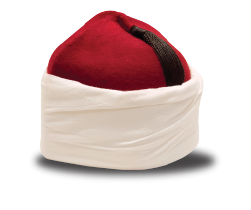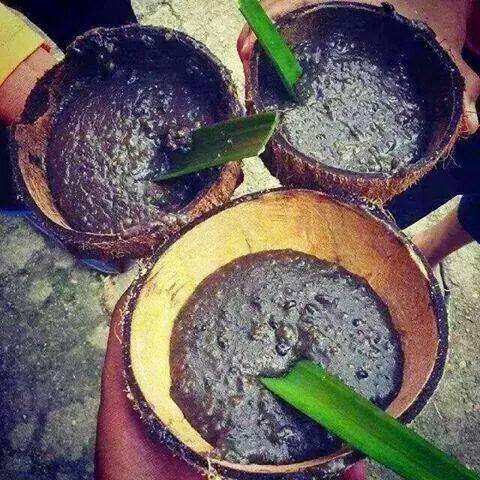Memoir Eng
Chapter 7: Days of Celebration in Islam
“What happened next, Granpa Aki? Why did Zul got expelled?” Sarah asked ardently.
“I’m sure you are dying to know right? Well, let’s take an interlude and I’ll tell you about the days of celebration we have in Terengganu.” Grandpa Aki decided suddenly as he sips the tea his wife made.
Sarah turned grouchy when Grandpa Aki chose to put his story on pause. “Hmm…suit yourself then!” Sarah pouted.
*****
Islamic festivities other than the Eidul Fitri are also celebrated by Muslims in Terengganu just like in other states in the 70s to the 80s, such as the Eidul Adha, Awal Muharram, Maulidurrasul, Isra’ Mi’raj, Nuzul Quran and Nisfu Sya’ban. However, there may be some differences in how they were celebrated based on the locality or states specifically the differences between the East and West Coast of Malaysia.
Awal Muharram
Awal Muharram or Ma’al Hijrah in Terengganu in the 70s and 80s isn’t celebrated as grand as the 10th Muharram or the day of Asyura. In Kubang Kekura, Kuca Sughe [1] Ceremony is a grand ceremony held annually. The villagers would come together and cook sughe at the imam, village chief or esteemed person’s house. The recipe for sughe in the East Coast is unlike in other states of the country. The ingredients include sauteed onions, ginger, galangal, meat, fish, corn, chicken, cassava shoots and rice as well as other spices. The meat used is usually from the excess meat from the sacrificial meat received during Qorban. This is a great cost saver as well as a great way to avoid waste. Sughe is cooked in large pots for more than 8 or 9 hours before being distributed in bowls of coconut shells lined with banana leaves. Its spoon is made from pineapple leaves.
Rabi’ul Awwal
What’s extraordinary for the month of Rabi’ul Awwal in Terengganu, for the celebration of Maulidurrasul is, it is filled with various interesting events and activities. Among them are a procession, religious sermons, Berzanji and Marhaban from house to house. In Kubang Kekura, the famous Berzanji and Marhaban members include Pok Dik, Ayoh Ngoh Toklat, Ayoh Ngoh Che Hussin, Ayoh Su Usop, Pok De We, Pok De, Mok De Joh, Ayoh Nik and several others.
They are invited to various villages to present their Berzanji and Marhaban recitations. If they are fortunate enough, two or three groups would get to meet each other and take the stage together. These groups will start their performances beginning after Zohor and pauses for Asar prayer before ending their performance after the feast after Asar prayer.
For the sly ones who would like to get a free meal, then they would just follow Pok Dik and his group and join in the performance. Just joining and imitating the other group members is enough. Not that anyone would notice even when they don’t sound just as good. Customarily, after each event, there will be a sumptuous feast prepared such as village chicken cooked in gravy and hard-boiled eggs cut in half and seasoned with pepper and salt.
For students and teachers, Maulidurrasul procession is a must and most awaited activity. Every school would send their representatives in colourful beautiful uniforms with khat writings and the lead would recite praises and salutation to the Prophet PBUH in his euphonious voice. The month of Rabi’ul Awwal is filled with sermons at the mosques and suraus. On occasion, preachers from Kuala Lumpur would be invited to deliver the sermon. When preachers from KL came, congregants will come from far and wide filling the mosques until they overflowed.
Indeed, the Maulidurrasul celebration is a great day to be celebrated serving as a reminder for the Muslim ummah especially the youths to remember our beloved Prophet PBUH. Syeikh Abdul Halim Mahmud once explained in his fatwa regarding the permissibility to celebrate Maulidurrasul stating: “Maulid of the Prophet PBUH celebration is a good way from the sunnah alluded by the Rasul PBUH when he said: “Whoever starts a good thing, then he will receive the rewards for it the same as the person who performs it, whoever starts a sinful thing, then he is as sinful as the person who commits it.” The reason is there is a basis that guides it and sahih dalil that is based on it. And it does not mean that when the salafussoleh did not practise it that it contradicts the syarak, for the salafussoleh has their own concerns and focus on the religion and love for the honoured prophet that they wouldn’t need for reminders to celebrate the birth of the prophet.” [2]
Isra’ Mikraj
The programs for Isra’ Mik’raj is much simpler. Usually, it is filled with religious sermons from local ustaz or sometimes ustaz from outside the village would also be invited. Some preachers would choose to discuss the book Kifayatul Muhtaj fi al-Isra’ wa al-Mi’raj. It’s a small book written by Shaykh Dāwūd bin ʿAbdullah al-Faṭānī which detailed the journey of Isra’ Mi’raj that the Prophet Muhammad PBUH went on. At the end of the ceremony, a feast of rice and various dishes are served with the East Coast chosen fruit as dessert and that is the watermelon.
Nisfu Sya’ban
The arrival of the month of Sya’aban is greatly anticipated by the Muslim ummah for it is a blessed month, a month of worship and a month of self-reflection and improvement. Sya’aban is a month in between the month of Rejab and Ramadhan. It is also one of the four holy months stated by Allah SWT in the Quran:
إِنَّ عِدَّةَ الشُّهُورِ عِندَ اللَّهِ اثْنَا عَشَرَ شَهْرًا فِي كِتَابِ اللَّهِ يَوْمَ خَلَقَ السَّمَاوَاتِ وَالْأَرْضَ مِنْهَا أَرْبَعَةٌ حُرُمٌ ۚ ذَٰلِكَ الدِّينُ الْقَيِّمُ ۚ فَلَا تَظْلِمُوا فِيهِنَّ أَنفُسَكُمْ ۚ وَقَاتِلُوا الْمُشْرِكِينَ كَافَّةً كَمَا يُقَاتِلُونَكُمْ كَافَّةً ۚ وَاعْلَمُوا أَنَّ اللَّهَ مَعَ الْمُتَّقِينَ
“Indeed, the number of months with Allah is twelve [lunar] months in the register of Allah [from] the day He created the heavens and the earth; of these, four are sacred. That is the correct religion, so do not wrong yourselves during them. And fight against the disbelievers collectively as they fight against you collectively. And know that Allah is with the righteous [who fear Him].” [3]
Commonly, every time it is Nisfu Sya’ban, the villagers would gather and prepare a huge feast at the surau. They would recite Yāsīn together after the Maghrib prayer three times. In the first recitation, they would pray for longevity to obey His commandments and avoid His prohibitions. In the second recitation they would ask for them to be showered with blessings and halal sustenance. While for the last and third recitation, they supplicate for strong and immovable faith.
Nuzul Quran
The Nuzul Quran celebration is a remembrance of the day in history where the Quran is first revealed to the Prophet Muhammad PBUH. Other than serving as a recitation, al-Quran is also a cure and healer for one’s heart and thoughts. It can change and guide the lives of people following His commandments and His Prophet’s teachings.
In the 70s, Nuzul Quran is rarely celebrated, for Muslims in Terengganu would focus on Tarawih prayer. During the day, they are busy with other worships and fasting. It is not until the late 80s that it become a customary celebration in mosques and surau.
Eidul Adha
It is not an exaggeration when it is said that the celebration of Eidul Adha on the East Coast is grander than the celebration of Eidul Fitri. Every year the worship of sacrifice is held whether at Haji Bakar’s or Ustaz Mad’s house. The price for a portion of a cow is RM60 or approximately RM450 for a whole cow. Villagers who intend to perform the worship of sacrifice would start to save since Muharram. After saving enough for the worship of sacrifice, villagers would register to participate in the sacrifice and the registration would usually end before 10th Zulhijjah or earlier. The cows can be easily sourced from the proprietor or maybe from ranchers or farmers from the village itself. It is very common for people in Terengganu to slaughter buffalo or sheep.
After the sunnah Eidul Adha prayer at the surau, villagers of Kampung Kubang Kekura will return home to get ready. The slaughterer and butcher will start by sharpening their knives and axes. Mothers would be busy in the kitchen preparing Fried Noodles, Nasi Dagang, kepok, coffee and tea for the feast that is going to be served during the sacrifice for everyone who participated. When it came down to the act of slaughtering itself, the children are the ones who are the most excited. They love watching the cows that are about to get slaughtered as well as the whole process itself. It’s a type of entertainment for them. There’s really not much to worry about when it comes to slaughtering cows, for in every village there is a person who is skilled and experienced that would lead the rest. However, there were times when the rope tying the cows would come loose. There was even a time when the slaughtered cow suddenly gets up and ran towards the slaughterer. The children burst out laughing watching everyone scrambling and running away.
The slaughtered cows will then get cut and sliced. The division and distribution are then done, weighing the meat for each participant, in accordance with the portions they paid for and distributed to the recipients. If there are wealthy people among the participants, then the villagers will be treated to sacrificial meat cooked in gravy.
*****
Grandpa Aki keeps on smiling silently alone, reminiscing back to the festivities he celebrated in his youth.
“Grandpa! Grandpa! Stop daydreaming.” Sarah shook her grandfather. “Can you please continue the story about Zul getting expelled?” Sarah asked breathlessly in anticipation. She was very annoyed earlier. Who wouldn’t be? When the story just reaches the climax, her grandfather decided to change the topic!
“Ha…ok, fine. I’ll continue…Hehe.” Grandpa Aki chuckles at his cute granddaughter’s request.
_________________
[1] Asyura porridge [2] Fatawa Imam Abdul Halim Mahmud, p. 273 [3] Sūrah al-Tawbah: 36
